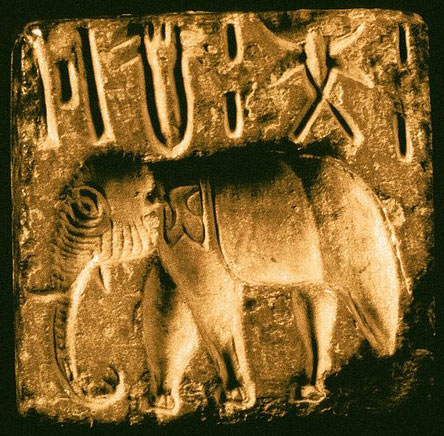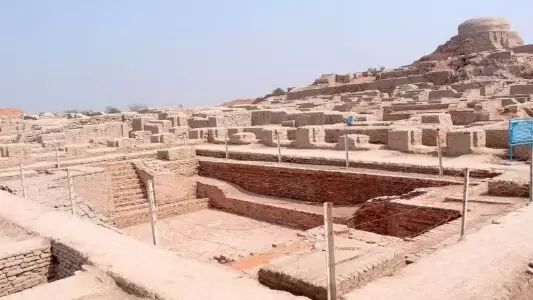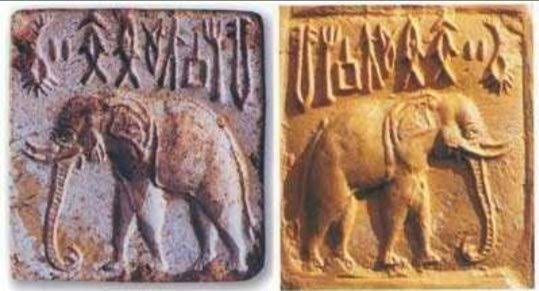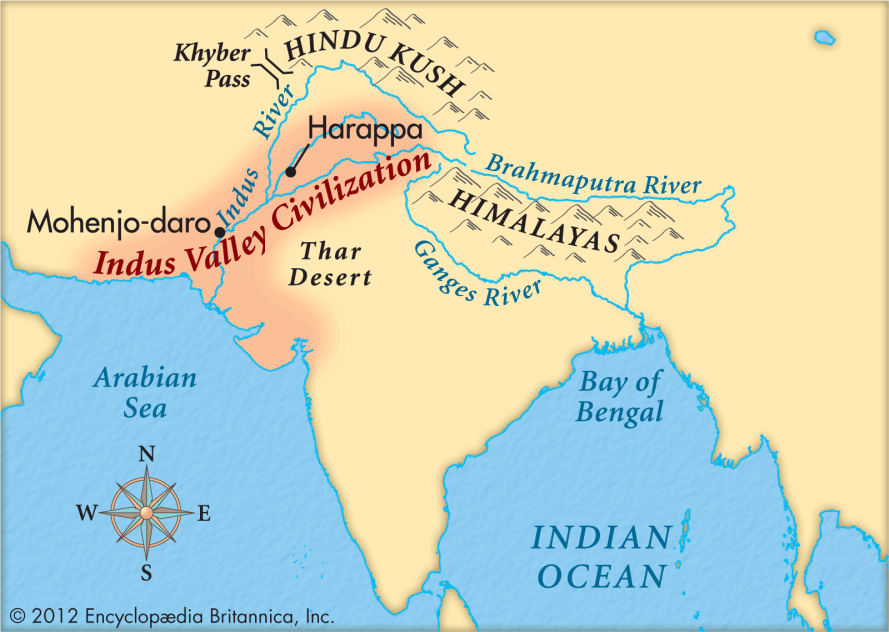
A significant population of Indus Valley Civilization spoke certain ancestral Dravidian languages. Ultra-conserved Dravidian tooth-word reveals deep linguistic ancestry and supports genetics.
Bahata Ansumali Mukhopadhyay
Ever since the discovery of Indus valley civilization (IVC), scholars have debated the linguistic identities of its people. This study analyzes numerous archaeological, linguistic, archaeogenetic and historical evidences to claim that the words used for elephant (like, ‘pīri’, ‘pīru’) in Bronze Age Mesopotamia, the elephant-word used in the Hurrian part of an Amarna letter of ca. 1400 BC, and the ivory-word (‘pîruš’) recorded in certain sixth century BC Old Persian documents, were all originally borrowed from ‘pīlu’, a Proto-Dravidian elephant-word, which was prevalent in the Indus valley civilization, and was etymologically related to the Proto-Dravidian tooth-word ‘*pal’ and its alternate forms (‘pīl’/‘piḷ’/‘pel’). This paper argues that there is sufficient morphophonemic evidence of an ancient Dravidian ‘*piḷ’/‘pīl’-based root, which meant ‘splitting/crushing’, and was semantically related to the meanings ‘tooth/tusk’. This paper further observes that ‘pīlu’ is among the most ancient and common phytonyms of the toothbrush tree Salvadora persica, which is a characteristic flora of Indus valley, and whose roots and twigs have been widely used as toothbrush in IVC regions since antiquity. This study claims that this phytonym ‘pīlu’ had also originated from the same Proto-Dravidian tooth-word, and argues that since IVC people had named their toothbrush trees and tuskers (elephants) using a Proto-Dravidian tooth-word, and since these names were widely used across IVC regions, a significant population of Indus valley civilization must have used that Proto-Dravidian tooth-word in their daily communication. Since ‘tooth’ belongs to the core non-borrowable ultra-conserved vocabulary of a speech community, its corollary is that a significant population of IVC spoke certain ancestral Dravidian languages. Important insights from recent archaeogenetic studies regarding possible migration of Proto-Dravidian speakers from Indus valley to South India also corroborate the findings of this paper]
 Indus valley civilization (IVC) and its linguistic diversity
Indus valley civilization (IVC) and its linguistic diversity
IVC, stretching across almost one million square kilometers of Pakistan, Afghanistan, and the North-Western part of India, was the most expansive of chalcolithic civilizations. Right from the discovery of IVC and its enigmatic script, several scholars have tried to trace the types of languages spoken in IVC. Types of languages presently spoken in the IVC regions are: Indo-Aryan (e.g., Punjabi in Punjab with dialects Siraiki and Lahnda, Sindhi in Sindh, Hindi, Marwari, Gujarati in eastern parts of Greater Indus Valley); Dardic (e.g., Shina, Khowar, Kohistani); Iranian (e.g., Baluchi, Dari, Pashto, and Wakhi in western parts of Greater Indus Valley); Nuristani in northeastern Afghanistan; Dravidian; Brahui (spoken in Baluchistan and Sindh); and Burushaski (a language isolate) spoken in northernmost Pakistan close to the Chinese border.
Since the ancient world was generally more multi-linguistic (12,000–20,000 languages existed before spread of agriculture, compared to some 7000 human languages of present times), ancient IVC too arguably hosted more languages than today. This makes it unlikely that all the languages spoken in its 1,00,0000 square-kilometer expanse belonged to only one linguistic group, whether Proto-Indo-Aryan, Proto-Dravidian or Proto-Austroasiatic. Languages of various groups, including some presently extinct languages, might have coexisted in IVC for ages, influencing and shaping one another.
The perennial puzzle regarding IVC languages: how archaeologists, linguists, historians and genetic anthropologists approach the problem
 Arguments from archaeology and linguistics
Arguments from archaeology and linguistics
Incommoded by the absence of any deciphered written record composed in IVC (Indus script is still undeciphered), scholars hold vastly different opinions regarding types of languages spoken in IVC. Once an advocate of the idea of a ‘Para-Munda’ (not ‘Proto-Munda’) speaking IVC, Witzel, presently prefers keeping the question of ‘original’ Indian language(s) ‘open’, till better reconstructions of Dravidian and Munda languages, and investigation of substrate words of ancient indigenous languages present in North-Indian Indo-Aryan languages are done. While many linguists have opposed the Austroasiatic-related hypotheses regarding IVC’s languages, Southworth shares Witzel’s ‘Para-Munda’ theory, despite vigorously advancing the idea of prehistoric Dravidian influence on various languages presently spoken in IVC regions (e.g., Sindh, Gujarat, and Maharashtra). Although some scholars claim that IVC language(s) belonged to some Proto-Indo-Aryan/Early-Indo-European language group, many others defend a Proto-Dravidian speaking IVC. Parpola proposes Proto-Dravidian etymologies of suspect substrate words (e.g., kiyāmbu, śakaṭam, oṁ, kinnara) present in Vedic texts, and certain suspect Indic words found in Mesopotamian texts (the ‘magilum’ boats of Meluhha); suggests that some of the fish-like signs of Indus script represented the Dravidian fish-word ‘mina’, to spell out certain Dravidian theophoric astral names prevalent in IVC; and adduces additional anthropological and ethnographic proofs of Dravidian influence, including Dravidian kinship and cross-cousin marriage rules practiced in the presently Indo-Aryan speaking societies of IVC regions (e.g. Gujarat). Though the prehistoric existence of ‘Language X’, an unknown primordial language not of proto-Indo-Aryan, Proto-Dravidian, or Proto-Munda type, was suggested by Masica’s analysis of various agricultural terms prevalent in some North-Indian languages, Masica has later commented that the Dravidian stock is “a strong but as yet unproven contender for the languages of the Harappans”.

Despite many such scholarly works, very few linguistic evidences, enjoying enough archaeological support to irrefutably identify the language(s) of IVC, have been offered so far. The situation is even more complicated due to several unresolved questions around the prehistoric spatio-temporal expanse of some major linguistic groups of present India (Indo-Aryan, Dravidian, and Austroasiatic), and their influences over one another. Dravidian-group languages, despite being spoken mostly in southern India (e.g., Tamil, Telugu, Kannada, Malayalam), also have scattered representations in India’s North-Western (Brahui), North-Eastern (Kuṛux, Malto), and Central (e.g., Kolami, Naiki, Parji, Ollari, Gadaba) parts, indicating that Dravidian speakers possibly had much greater pre-historic presence in Northern India, including IVC regions. Moreover, Mathematical linguistic studies confirm that Proto-Dravidian existed in the time of IVC. Similarly, though Austroasiatic languages (e.g., Mundari, Santali, Khasi) are currently spoken mostly in North-Eastern India, presence of the isolated Austroasiatic language Korku amidst Dravidian-speaking Gondis and other Indo-Aryan speakers in Madhya Pradesh and Maharashtra, indicates the possibility of a wider Austroasiatic presence in pre-historic India. Such uncertainties about spatio-temporal expanse assail even Indo-Aryan languages, the most dominant language-group of present North India, which has provided us with Ṛgveda and Atharvaveda, the oldest Indian texts composed in Sanskrit. Whether Indo-Aryan languages entered India from outside after IVC’s decline, or were present in India since or from before the IVC era and were spoken in IVC, are questions that have enjoyed almost 200 years of scholarly attention, along with innumerable amateurish attempts, often motivated by identity-politics.
Arguments from archaeogenetics
Parallel to archaeology and linguistics, archaeogenetics can immensely help us reconstruct the linguistic pre-history of a region. For example, a recent cross-disciplinary archaeogenetic study, not only infers “a likely genetic signature for people of the IVC”, but also suggests interesting theories regarding Proto-Dravidian’s spread. This study postulates that having different proportions of Iranian-farmer-related ancestry and Ancient-Ancestral-South-Indian-related ancestry “was a characteristic feature of many IVC people”. It states that after “IVC’s decline, this population mixed with northwestern groups with Steppe ancestry, to form ‘Ancestral North Indians’ (ANI), and also mixed with southeastern groups to form ‘Ancestral South Indians’ (ASI), whose direct descendants today live in tribal groups in southern India”. It argues that “[mixtures of these two post-IVC groups—the ANI and ASI—drive the main gradient of genetic variation in South Asia today”.
Most relevantly, this archaeogenetic study states that quite possibly “Proto-Dravidian was spread by peoples of IVC along with the Indus Periphery Cline ancestry component of the ASI [Ancestral-South-Indian]”. [Here Indus Periphery Cline refers to the ethnicity of IVC-era individuals whose remains were recovered from burials of two sites in cultural contact with IVC. These individuals are conjectured to be migrants from IVC, as their genomes do not fit the genomes of the core population found in their burial-sites, but fit well with genomes of 86 Post-IVC (1200–800 BC) people living near the headwaters of river Indus, and also genomes of diverse present-day South-Asians]. However, Narasimhan et al. do not deny the alternative possibility that “Proto-Dravidian was spread by the half of the ASI’s ancestry that was not from the Indus Periphery Cline and instead derived from the south and the east (peninsular South Asia)”.
Another related genomic study (Shinde et al., 2019) analyzes the genome of one IVC-era individual from Rakhigarhi, a longstanding Indus settlement, and discusses how that individual shared the same Iranian-farmer-related ancestry as of Indus Periphery Cline individuals, but little if any Steppe pastoralist-derived ancestry, and how this Iranian-farmer-related ancestry had diverged from the western Iranian people since at least 8000 BC.
Genetic ancestries and languages not being always linearly correlated, these studies, although quite helpful, do not suffice for a sure call regarding the dominant linguistic group(s) extant in IVC. For, they do not tell us which language(s) were spoken by the IVC’s ancestors, after their ancestors, and predecessors of western Iranian people had split around 8000 BC. Nor can the genetic data surely say if Dravidian languages originated in IVC or in the southern Indian peninsula.
Click here for Full Research Paper
________________
Courtesy: Nature